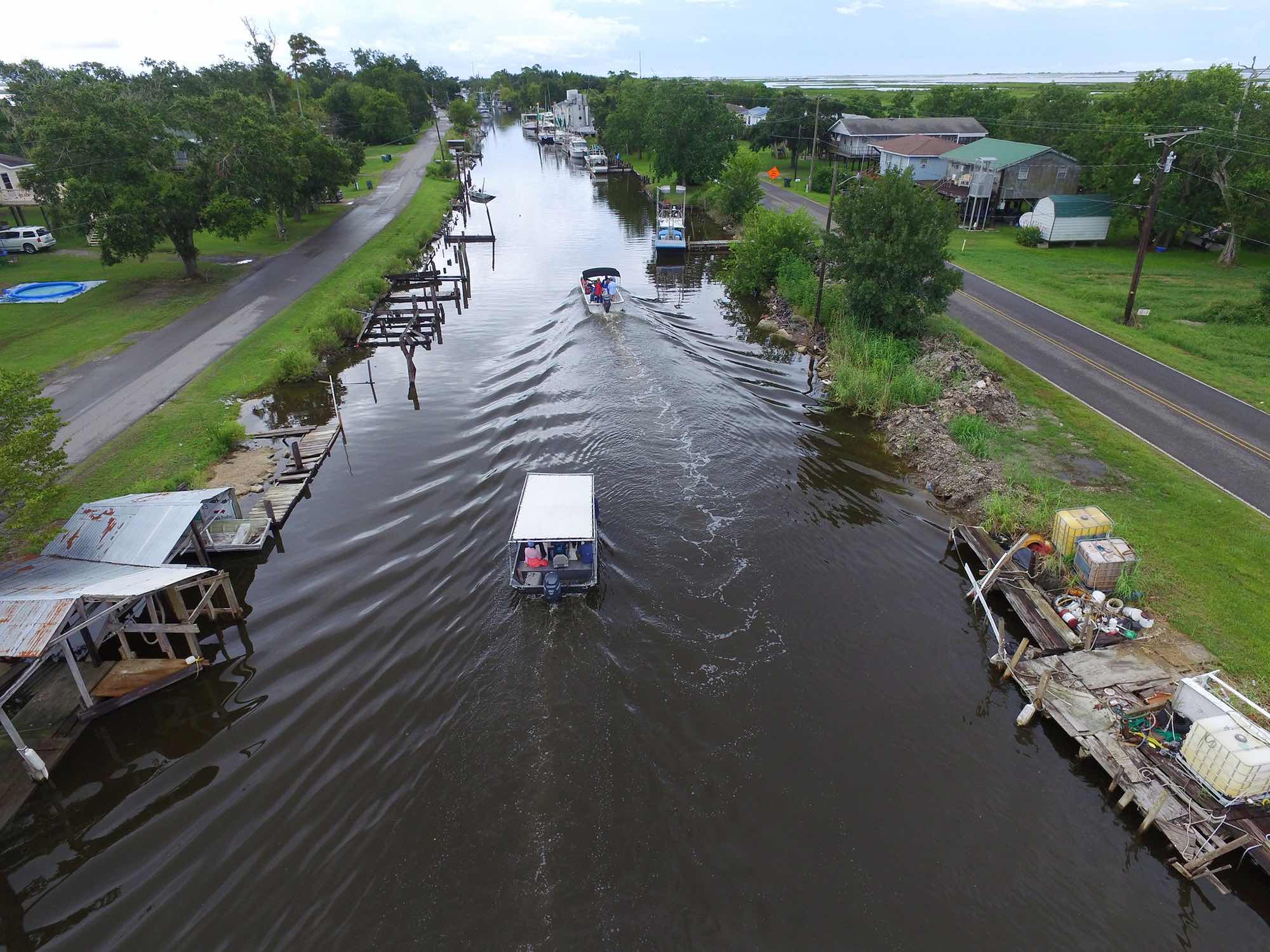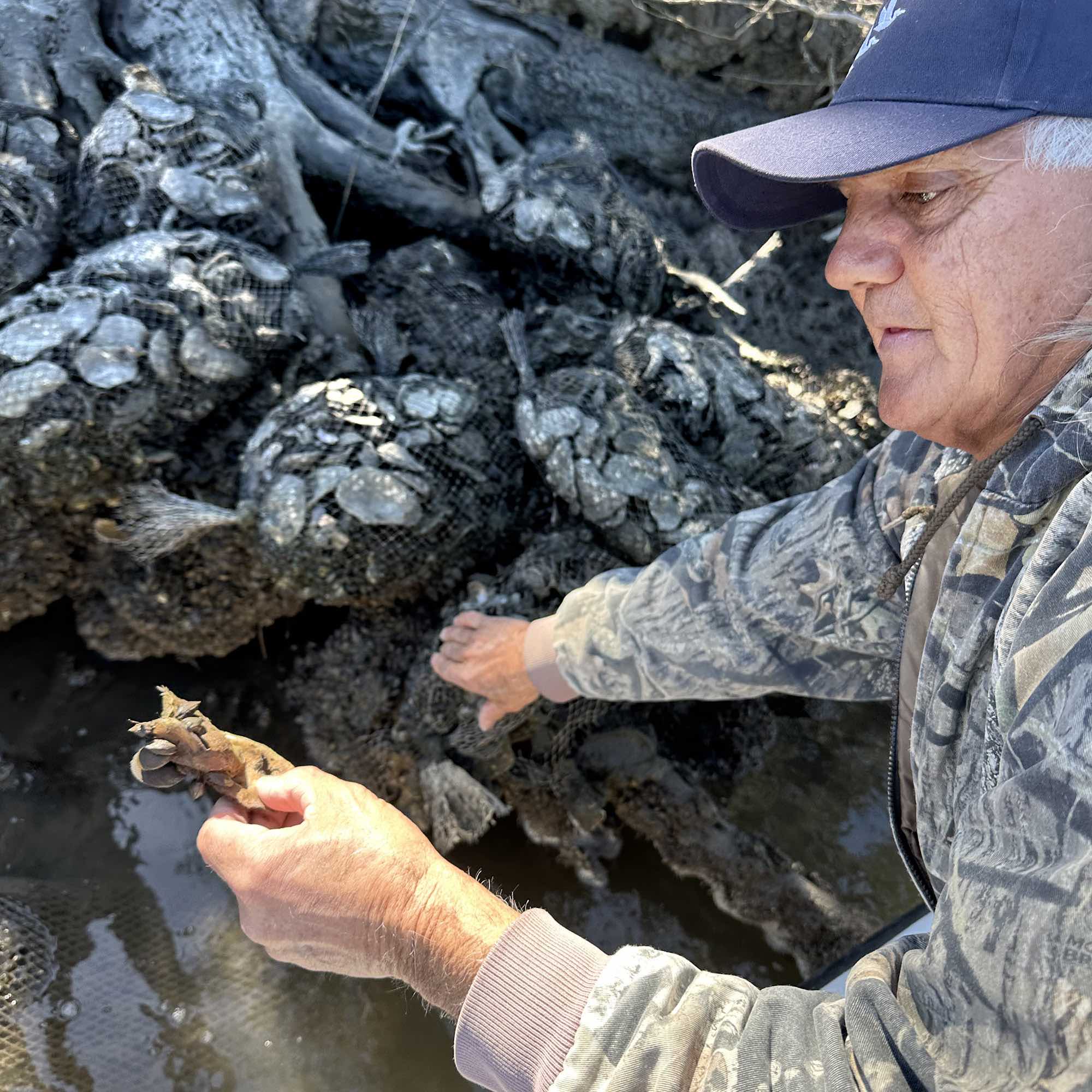LSU Awarded $780K from National Academies to Help Louisiana Tribe Protect Coastal Land
January 08, 2024
Pointe-au-Chien, southeast of Houma, Louisiana, and close to Lafitte, juts out into the Gulf of Mexico on the edge of Terrebonne Bay—a gorgeous but delicate piece of land. The Pointe-au-Chien Indian Tribe, or PACIT, established their fishing, hunting, and farming community in Pointe-au-Chien before the arrival of the first Europeans, making it one of Louisiana’s oldest settlements. The area is also one of the world’s most threatened, as it struggles with environmental challenges, including storm surge, that make Terrebonne basin North America’s fastest eroding basin.

Pointe-au-Chien, southeast of Houma, LA.
Since 2022, LSU has been working with PACIT to protect the tribe’s ancestral lands using nature-based solutions. Matthew Bethel, associate executive director of research at Louisiana Sea Grant, has been leading the project, converting the success of an initial $100,000 planning grant into a full-fledged $780,000 design project funded by the National Academies of Sciences, Engineering, and Medicine’s Gulf Research Program.
“We lead this work by learning from the Tribe’s perspective and factoring in traditional ecological knowledge and priorities from the Tribe,” Bethel said. “At a larger scale, our collaborative can be adopted, adapted, and applied by researchers working with almost any community on local issues.”
Nature-based solutions can take many forms, such as freshwater introductions, marsh creation, native vegetation plantings, and rain gardens. But the most popular solution that emerged during the initial planning phase was to create a network of “living shorelines” from grasses and other organic materials, including man-made oyster reefs, to strengthen vulnerable marshes and reduce storm surge.
“The tribe tried and really liked the Coalition to Restore Coastal Louisiana’s oyster shell recycling project,” Bethel said. “That’s where they place oyster shells in areas needing protection. These not only serve as shoreline protection systems, but also help baby oysters grow, and fish and crab colonies thrive.”
The Coalition to Restore Coastal Louisiana, or CRCL, is a partner on Louisiana Sea Grant’s expanded project.
“In 2019, CRCL and its partners had put in an oyster shell living shoreline along an earthen mound of cultural significance that had eroded because of a nearby canal cut into the marsh,” Bethel said. “Then Hurricane Ida passed right over the mound. But when they went out to check it later, that oyster reef had held up. So, the Tribe liked what they saw—that it was protected from a Category 4 hurricane—and now they want to do more of that kind of project.”
The planning process involved focus group meetings with older and younger Tribe members and meetings with subject matter experts, parish officials, levee district officials, leadership from a neighboring tribe, the National Oceanic and Atmospheric Administration, and regional groups like the Gulf of Mexico Alliance and the Coalition to Restore Coastal Louisiana.
“Nature-based solutions are a critical piece of the community resilience puzzle, creating multiple benefits and additional value for communities,” said Daniel Burger, senior program manager of the Gulf Research Program’s Gulf Health and Resilience Board. “[Louisiana Sea Grant’s project with PACIT] will demonstrate the value added by the inclusion of community members in the planning and design of projects that reduce exposure to weather and climate hazards.”
Tribe member and Cultural Heritage & Resiliency Coordinator Cherie Matherne appreciates how the first phase of the project combined the use of new technology with tribal observations and experiences.
“We had a meeting where the researchers brought a software along where they could locate which areas most need protection,” Matherne said. “This software, which they’ve also used along the Florida coast, can identify which places are most vulnerable, and combining that with the experience of the Tribe and what we know about certain parts of our coasts and where the currents are hitting harder, is very valuable. The model also makes recommendations about what materials to use, whether a certain area needs us to plant vegetation, or things like oyster shells or rocks.”

Second Chairman Donald Dardar shows an oyster shell shoreline protection reef.
Matherne is a fourth-generation Tribe member who’s seen land and livelihoods change and heard from elders about radically different lives and landscapes.
“The older generation remembers the land with trees, they remember raising cattle on the land,” Matherne said. “The land has since eroded so much there are no longer any trees, and no real land to raise cattle. Behind my office is where the Morganza levee system passes on the Island Road. That area between the levee and the island used to be all land, and now it’s all open water. Trapping also used to be a big source of income, but no one traps anymore because there isn’t enough land.”
That leaves fishing, crabbing, shrimping, and oysters as the main sources of income in Pointe-au-Chien, but those activities are endangered, too.
“With our land disappearing, it has a big effect on our fisheries because the shrimp and crabs don’t have anywhere to reproduce,” Matherne said. “The places they would normally go are gone. So, the erosion not only affects us not being able to live here in this bayou community, but many of the resident fishermen rely on that income to raise their families.”
Other than Matthew Bethel, there are several Louisiana Sea Grant researchers on the project, including Niki Pace, Melissa Daigle, Earl Melancon, Julie Falgout, DeWitt Braud, and Haley Gambill; Georgie Ferguson with the Pointe-au-Chien Indian Tribe; Darrah Bach with the Coalition to Restore Coastal Louisiana; as well as researchers from other universities.
The National Academies’ Gulf Research Program, founded in 2013 as part of legal settlements with the companies involved in the 2010 Deepwater Horizon disaster, has $500 million for use over 30 years to help struggling communities that rely on the Gulf of Mexico.
Read more:
Louisiana Sea Grant Part of $1 Million Planning Grants to Support Nature-Based Solutions


